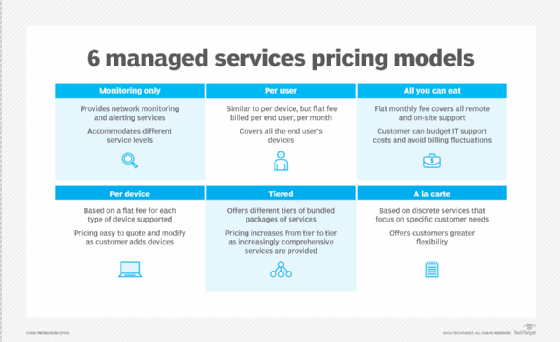managed network services
What are managed network services?
Managed network services are networking applications, functions and services that enterprises outsource to be remotely operated, monitored and maintained by a managed service provider (MSP).
Managed network services range from basic network access and transport services like traditional leased WAN and LAN lines to newer software-defined WAN (SD-WAN) connections and virtual network services. Beyond network access and transport services, the variety of available managed services includes the following examples:
- WAN optimization
- unified messaging
- network administration
- network provisioning
- cabling installation
- network monitoring
- managed security firewalls
- virtual private networks (VPNs)
The role of MSPs
MSPs primarily host managed enterprise network services in their own data centers and facilities, where they can also host virtual network functions. MSPs range in size from small niche service providers to large traditional national and global telecommunications providers.
MSPs typically offer managed network services with service-level agreements (SLAs) for customers, which are contractual arrangements that spell out the performance and quality metrics under which the managed service will be provided.
Benefits of managed network services
Small and medium-sized businesses often contract with MSPs because they have limited in-house IT capabilities and staff. Managed network services offer a way for organizations to obtain IT and networking expertise without hiring more staff.
MSPs can handle enterprise networking issues that include integration, troubleshooting, technical support and policy setting. Managed network services are also a viable option for companies that are interested in trying out new technologies, but leery of the associated risks and complexity.
Managed network services enable companies to free up their existing IT staff to focus on other tasks. This results in operational efficiency because MSPs can monitor the needed services and troubleshoot when needed.
Because MSPs take a proactive network management approach, they might be able to prevent IT problems from disrupting business operations. Larger enterprises, organizations or government agencies also contract with MSPs when they face budget pressure and hiring limitations to supplement in-house IT staff.
Challenges of managed network services
Many business customers consider the ability to hand network and service management over to an MSP as both an advantage and a risk. To manage risk, it's important for customers to clearly define their expectations and requirements in SLAs with their MSPs. Throughout the relationship, companies should monitor MSP performance and make sure it's consistent with the terms of their contract. SLA factors can include quality of service (QoS), reliability, availability, scope of services and customer responsibilities.
Customer support also presents a challenge with managed network services. Depending on MSP response times, enterprises might face longer wait times for technical issues.
Pricing models for managed network services can also be complicated, with tiered options or a-la-carte options.

Managed network services pricing models
Enterprises usually sign an annual or multi-year service contract with an MSP for managed network services. Pricing formulas can be complex, based on the type of service, speed, interfaces, geographies, number of sites and level of managed support offered.
Some common pricing models for managed network services include the following:
- monitoring only
- per device
- per user
- a la carte
- tiered
- all you can eat
Once the specifics of a service are established, one advantage for business customers is the ability to budget fixed monthly expenses. Managed services also enable enterprises to move these costs out of their capital expense budgets -- used to maintain and buy new equipment -- into their operations expense budgets.
For MSPs, being in the business of offering managed network services provides a predictable monthly revenue stream from customers. The value of having fixed recurring revenue has attracted many traditional service providers to add managed services to their operations.
History of managed network services
Network providers have offered managed services for decades. Centrex, a managed private branch exchange (PBX) service, is an early example of a managed service developed in the 1960s. Centrex provided enterprise telephony services remotely using communications equipment and software owned by the telephone company and located on switches in its central offices, not on the customers' premises.
Managed services continued to change over the years as networks evolved. When the Bell System monopoly broke up in 1984 and seven individual Regional Bell Operating Companies (RBOCs) emerged to offer local telephone services, some business customers wanted the ability to contract with one provider rather than negotiate services with the RBOCs individually. This led to more growth in managed connectivity services.
The Telecommunications Act of 1996 led to the rise of competitive local exchange carriers (CLECs) that could offer communications services in addition to the RBOCs. Customers then had a wider range of providers from which to choose. To simplify the management of multiple connections with different service providers, the primary MSP also handled its customers' connections with other service providers.
In the 1990s, application service providers (ASPs) emerged to offer remote application hosting services. ASPs paved the way for service providers to offer remote support for customers' IT infrastructure. These companies are also referred to as MSPs or IT solution providers, although their service model differs from managed network services.
With the emergence of software-based networking technologies around 2010, MSPs began offering services to manage newer cross-provider virtual network services like SD-WAN. As a result, MSPs have increasingly incorporated SD-WAN into their enterprise managed services portfolios, often partnering with SD-WAN vendors to underpin the services. The availability of managed SD-WAN services negates the need for enterprises to manage numerous connections with different service providers based on their geographic locations.
An evolution of managed network services is network as a service (NaaS). With NaaS, service providers offer network services -- including hardware, software, management and licensing -- on a subscription basis. Common examples of NaaS include SD-WAN and Secure Access Service Edge (SASE).



